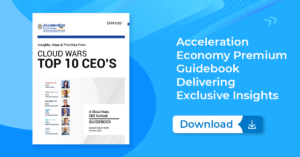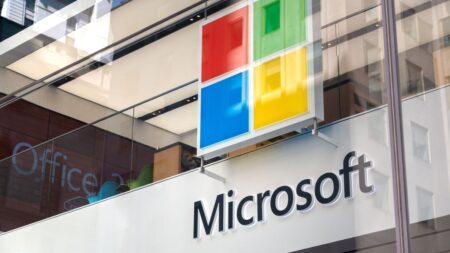
Oracle is sharply differentiating itself from fellow hyperscalers Amazon, Microsoft and Google by planning to build “hundreds of data centers” across the globe with at least one “in every country in the world,” chairman Larry Ellison said last week.
That stunning admission came in an intimate setting at the Oracle Database Summit, where Ellison made a surprise visit via Zoom and answered questions from analysts (including your humble correspondent) for more than an hour.
Dramatically Different Approach
The significance behind Ellison’s revelation is that the planned global buildout of “hundreds” of relatively small and low-cost Oracle cloud data runs completely counter to what the other hyperscalers are doing. For customers, the potential appeal of the Oracle plan would be greater accessibility to widespread and consistent cloud regions for purposes of data sovereignty, cybersecurity, privacy, lower latency, and more.
As Ellison put it on the Zoom call with analysts, “Here’s another reason why the Oracle Cloud is fundamentally different from what the other three hyperscalers are doing: they’re all building a small number of huge and very expensive data centers, but we plan to build hundreds — all fully automated, and all running every single one of our cloud services, which is not the case with the others. They have some services in some regions but not in others — and by the way, that doesn’t make any sense for their customers.
“Ours might come in different sizes depending on local need, but the architecture in each will be exactly the same — and we’re gonna build hundreds of them.”
‘Every Country in the World’
While Ellison did not offer a timetable for this global buildout, he was quite specific in saying that Oracle will build “at least one” in “every country in the world.”
Oracle’s able to go down this very different path, Ellison said, because it has taken a radically different approach with the advanced technologies that make up what it calls its Gen2 Oracle Cloud Infrastructure. The result, he says, is an architecture that is not only faster and more powerful than what Oracle’s competitors can offer, but also much less expensive to build — and Oracle’s eagerly passing along those savings to customers.
(For more on Ellison’s articulation of Oracle’s unique cloud strategy, please check out my analysis from earlier this week and also stemming from the Zoom conversation with Ellison: Larry Ellison Unplugged: ‘Preposterous’ AWS Policy, Reconnecting the World, and Fastest Computer on Earth.)
By contrast, Ellison said, the first-generation cloud architectures designed and deployed by AWS, Microsoft, and Google require that their data centers be massive in scale and expense, with those two essential parameters limiting the ability of those major cloud vendors to match the ambitious global buildout Ellison described.
Cloud Regions Inside Customer Data Centers
“Our cloud data centers are not very expensive,” Ellison said. “They’re only a tiny fraction of what it costs to build an AWS data center.
“In fact, ours are cheap enough that we’ve been able to provide some customers with an absolutely identical dedicated cloud region in their own data center — inside their own building! The other guys can’t do that,” Ellison said.
“But by design, we’ve scaled ours down to make them much smaller, and our intention is to put at least one in every country in the world… By doing that, we don’t have to have such a battle with the speed of light because our data centers are so much closer to where the customers are and so the latency is lower.
“Plus, the lower the latency, the lower the cost of moving the data around — so again, we can be much less expensive,” Ellison said.
Like Elon Musk and Starlink
“You could compare our strategy to what Elon Musk is doing with Starlink — instead of a very small number of very large and expensive satellites very far from Earth, he’s launching a much larger number of smaller satellites that are much closer to Earth and are much, much less expensive,” he said.
Hard-Earned Lessons
Ellison freely admitted that Oracle’s first attempt at cloud infrastructure was modeled directly after what the three original hyperscalers were doing, resulting in a complete lack of differentiation against far larger and wealthier competitors.
But while that first foray into infrastructure was a bust, it did provide Ellison and Oracle with some important lessons.
“That’s why shut down our first version of the Oracle Cloud — we didn’t offer anything different,” he said.
“But now, how come our latency is lower? How come our network is faster? It’s because of our unique design. If you rent a computer from Amazon, inside that computer is your code and Amazon’s code,” Ellison said.
“But the Oracle Cloud doesn’t work that way. If you want to rent a computer from us, you’re the only one who uses it — no one else has that — no one else is built like that. If you want us to set you up with a whole computer of your own, and have own network that no one can penetrate, we can do that — you can’t see what we’re doing, and more important, we can’t see what you’re doing,” Ellison said.
“So we can have a cloud that is not only much faster and much more secure but is also less expensive because we spend less.”
Size Matters — But So Does Market Momentum
Now, I need to point out that while all of this sounds great, the reality in the market right now is that Oracle’s cloud-infrastructure business remains much smaller than those of its competitors. Here are my rough estimates for each company’s total cloud revenue for calendar 2023:
- Oracle will do about $20 billion
- Microsoft will do about $110 billion, or 5.5X more than Oracle
- AWS will do about $90 billion, or 4.5X more than Oracle
- Google Cloud will do about $36 billion, or about 80% more than Oracle
At the same time, however, Oracle’s cloud business is growing much faster than those of the original hyperscalers: its total cloud business was up 45% in its most recent quarter, with cloud-infrastructure revenue up 55% to $1.2 billion.
Plus, OCI now has about 20,000 customers, each of which no doubt looked at what Amazon, Microsoft, and Google were offering and instead decided to go with Oracle. So in spite of the vast size differentials, the market momentum behind Oracle Cloud is undeniable.
Final Thought
Larry Ellison has never taken the conventional approach. About 14 years ago, as most major tech vendors were racing away from hardware, he jumped in and bought Sun Microsystems, whose core technology remains an intimate ingredient of the Oracle Cloud.
When just about everyone said the three original hyperscalers were so big and wealthy and so deeply entrenched that it would be suicidal for some newcomer to enter the market, Ellison jumped right in and established a powerful position.
And in the America’s Cup competition about 10 years ago, Ellison conceived a breakthrough fixed-wing sail and a trimaran hull of giant scale while everyone else went with traditional sales and catamarans. (Ellison’s team won, by the way, after having gone through painful losses in the previous America’s Cup competition.)
So it was with a bit of a Cheshire Cat smile that Ellison conceded that the road to Oracle’s current cloud ascendancy has not been smooth — and yet, here they are.
“We were a little bit late in cloud infrastructure, but that gave us the advantage of seeing what the other guys were doing. And eventually, I knew we had to do something different,” he said.
“And now, I like our chances.”










